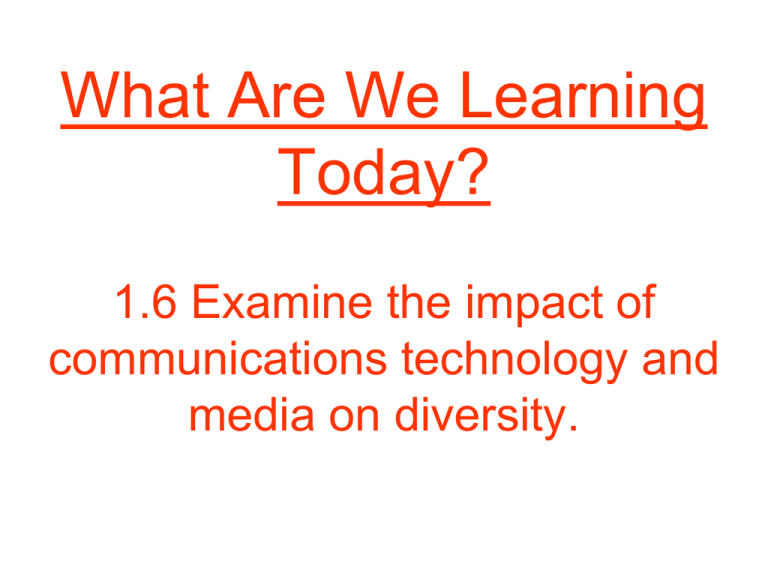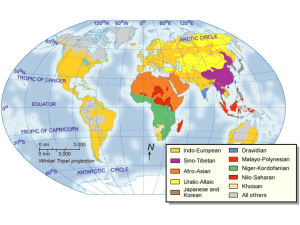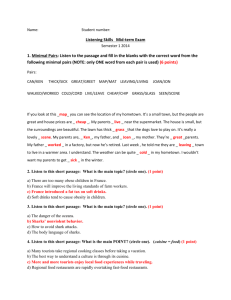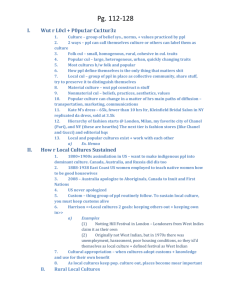091510 Unit 1
advertisement

What Are We Learning Today? 1.6 Examine the impact of communications technology and media on diversity. How many of you own cell phones? How many times do you use your cell phone a day? How many calls? How many text messages? What factors influence your communication method (when do you text vs. when do you call)? Communication Technology & Choices • Contemporary (modern) digital communication technologies (telephones, cell phones, computers, and the World Wide Web) expand the communication choices available and help you stay closely connected to friends and family, as well as to others in your community and beyond. • At one time, distance was a huge barrier to communication, but today’s digital technology has nearly eliminated this barrier. (FYI pg. 68) Anik A1 • In 1972, Canada launched a satellite called the Anik A1 – and indicated a new era in communication in Canada’s North and other remote areas. Over the following decades, satellite technology – which captures signals sent from transmitters on Earth and bounces them back to receivers in TV sets – improved greatly. (Figure 3-5) Aboriginal Peoples TV Network • In 1999, technology like the Anik A1 satellite helped the Aboriginal Peoples Television Network create a nationwide TV service for Aboriginal ppl. • Based in Winnipeg, Manitoba, APTN was the world’s first national public Aboriginal TV network. It goal is to create programs “by, for and about Aboriginal peoples” – and to share these programs with all Canadians. What is a monopoly? Could there ever be a monopoly on the media? Why might a monopoly or a strong media concentration of a few big companies be a bad thing? Definitions • Media concentration: the gathering of ownership of newspapers and other media in the hands of a few large corporations. • Media convergence: the use of electronic technology to combine media such as TV, books, newspapers, and the Internet. • Propaganda: Ideas and information spread for the purpose of achieving a specific goal. Canadian Media Concentration • Critics of media concentration argue that it reduces competition and diversity of opinion. • Columnist Jill Nelson, for example, has said that media concentration/convergence “may be good for business, but it’s bad for people and the free flow of information. In our lust for profits, we have forgotten democratic principles. This can only increase the public’s deep skepticism of the quality of the news.” • Why might the Canadian public be skeptical of the news it receives? The news – from whose perspective? • ~1970: 40% of Canada’s English newspapers and 50% of Canada’s French newspapers were independently owned. • 2003: 96% of Canada’s newspapers are owned by larger corporations. – 50% of the 96% are owned by one company: CanWest Global • 2003: Only 3 Canadian newspapers are still privately owned (Winnipeg Free Press, White Horse Star, Le Devoir (Montreal)). • • • • • • • • • CTV TSN and TSN2 Access Network MuchMusic MTV and MTV2 The Comedy Network Discovery Channel 35 radio stations (Energy 101.5 FM) The Globe and Mail • • • • • • • • • Rogers Wireless & Fido Rogers Sportsnet Citytv OMNI The Shopping Channel The Biography Channel More than 70 consumer magazines (Maclean’s) 51 Canadian radio stations (JACK FM) Rogers Cable (mainly southern Ontario) • Most major Canadian newspapers (National Post, Calgary Herald, Edmonton Journal, etc.) • Global Television Network • Men TV • Prime TV • Mystery • DejaView • Lonestar • Fox Sportsworld Canada Negatives of a Canadian Media Monopoly • One example of the danger of a select few Canadian companies controlling most of the country’s media was shown when CanWest Global tried to get most of their daily newspapers to take the same editorial position, regardless of local and regional differences. • Journalists who resisted were fired. Also, the publisher of the Ottawa Citizen lost his job after the paper published an editorial that had not been approved by the CanWest head office. CanWest later changed the policy. (Figure 3-9) Diversity & Global Media Concentration • 2nd half pg. 72 As Canadians, do we have complete access to any type of media we want? Al-Jazeera in North America • In 1996, satellite technology, cable networks, and the Internet enabled Al-Jazeera, an Arabic TV station, to begin broadcasting internationally from Qatar, a country in the Arabian Peninsula. • Some ppl believe that Al-Jazeera provides nothing but propaganda but others disagree. They believe that being exposed to a wide range of views is important. • What propaganda might Al-Jazeera be spreading that would alarm Canadians? No Al-Jazeera in North America • So far, North American TV viewers cannot watch Al-Jazeera. In 2004, the Canadian Radio-television and Telecommunications Commission, the agency that regulates broadcasting in Canada, ruled that Al-Jazeera could broadcast an English-language version of its programs in this country. • But the CRTC set strict conditions: cable operators who offered Al-Jazeera would be required to monitor its broadcasts and delete anything that broke Canada’s hate laws. Doing this would be difficult – and so far, no Canadian cable company has agreed to it. (FYI pg. 73) Diversity and the Internet • Not everyone is in a position to benefit from global communication. Indigenous ppls, for example, have had to struggle to make sure their many voices are heard on the World Wide Web. • Often the needs of marginalized and vulnerable groups, as well as the preservation of the heritage and cultural legacy of Indigenous ppls have been ignored. • What do I mean by this? Francophone Representation • In Canada, the commissioner of official languages produced a report stressing that, in a globalizing world, maintaining a strong French presence on the Internet requires continuous effort. • In Western Canada, media and services are overwhelmingly English, and Francophone communities are often widely separated. In Alberta, Francophone communities are taking steps to keep their culture strong. With the help of the Alberta gov’t, they are, for example, digitizing their histories and posting them on the Internet. Can increased technology make you lonelier? Techno-Isolation • Think about how current communication technologies can enable you to create your own world. During class time when you’re allowed to use your MP3 player, you can listen to your customized soundtrack and block out the rest of the world (and your annoying teacher). • When sitting with your friends after school, you can talk or send text messages on your cell phone while sitting at a table surrounded by ppl your are not communicating with. High-Tech Hermits • Though some ppl believe that technology increases connections among ppl, others argue that it actually promotes social isolation by encouraging ppl to become “high-tech hermits.” • Technology enables ppl to pursue their own interests, but doing this can reduce their sense of community. • Psychotherapist Tina Tessina says “People don’t automatically have the same cultural events to talk about. We have so much choice that ppl at the water cooler haven’t all seen the same thing, read the same book or heard the same news.” (Figure 3-11) New Ways of Interacting • At the same time, there are those who deny that technology is isolating. Instead, they say it can result in interesting ways of interacting. • For example, owners of MP3 players can listen to one another’s music. Strangers meeting on the street listen to each other’s selections, creating different kinds of social connections. • And of course, there is social networking. Websites like Facebook allow us to communicate with ppl around the world in ways we never could have previously imagined. The Digital Divide • The 1st source of information many ppl choose is the Internet. But most of the world’s ppl do not have Internet access. (Figure 3-3) • The digital divide explains the gap that separates ppl who do – and do not – have access to up-to-date digital technology. • Even in countries like Canada, a digital divide exists. High-speed Internet access is not available in some rural areas. They cannot afford Internet service. Language also presents a challenge. Few web sites, for example, are available in Aboriginal languages. One Laptop per Child • Pg. 69 • Figure 3-4 • http://www.youtube.com/watch?v=7kHIZXYJbW Y What was the biggest news th story of the 20 century? http://www.youtube.com/watch?v=KPW_E16f mwc&feature=related http://www.youtube.com/watch?v=2K8Q3cqG s7I&feature=related John F. Kennedy Jr. • 1st half pg. 76 • Figure 3-12 What was the biggest news story of the 21st century? http://www.youtube.com/watch?v=eLN6TtYTQCc&feature=related (until 5:02) http://www.youtube.com/watch?v=jaxo8-mvSCg&feature=related (until 4:18) http://www.youtube.com/watch?v=zOflyabs0_w&feature=related (until 2:11) http://www.youtube.com/watch?v=FYg2krLsPB8 (until 1:59) http://www.youtube.com/watch?v=Ul--oYht2RE September 11, 2001 • 2nd half pg. 76 • 1st half pg. 77 • Voices pg. 77 Dealing with the Backlash • In some Western countries, ppl of Middle Eastern heritage – or ppl who looked as if they might be from the Middle East – were harassed. Mosques (Muslim temples) were firebombed in the US, France, Australia, and Canada, and some Muslims were mistakenly arrested for engaging in “terrorist” activities. Positives of Communication: Live 8 • In July of 2005, a series of concerts featuring hundreds of int’l artists were organized by Make Poverty History. They occurred in cities around the world and satellite links connected the concerts as they were happening. • Make Poverty History is a coalition of non-profit organizations around the world and is dedicated to eradicating poverty. The concerts were held to increase awareness of global poverty and influence world leaders to take action to end it. Live 8 & the G8 • Why July? Officials from the world’s 8 leading industrial countries – the Group of 8, or G8 – were meeting in Scotland at the time. Leaders of the G8 countries, which include Canada, meet every year to discuss international issues. The concerts were called Live 8 as a play on “G8.” • The Live 8 organizers asked the G8 leaders to: - ensure justice in trade - cancel debt in the poorest countries - deliver more and better aid to those countries. Making Poverty History • About 3 billion people around the world participated in the concerts via radio, TV, and Internet links. During the concerts, more than 26.4 million ppl sent text messages to support the goal of making poverty history. http://www.youtube.com/watch?v=J ZzpqtekRoI Missing Voices • The concerts were mainly put in place to help the continent of Africa. However, only two African-born performers were invited to perform. – (Youssou N’Dour from Senegal and Dave Matthews from South Africa) • Some critics wondered what this said about the organizers’ attitude to Africans. In response, African entertainers organized African Calling, a concert in England that featured African performers, though this event was not televised. (Figure 3-15, pg 80) Homework • Answer the following questions based on what you learned/know about Live 8: 1. Was the idea to not include lesser known African artists a smart one on Live 8’s part? 2. Without the int’l celebrities, would Live 8 have captured int’l media interests? 3. What does this say about media responses to world problems and about celebrity status in the media? A Quick Response • Another advantage of increased communication technology: it is often the catalyst for a generous response from people around the world. • Ex: the tsunami of December 26, 2004. This tsunami, which was caused by an earthquake in the Indian Ocean, caught the attention of the media and the world. By the end of that day, more than 150,000 people in 11 countries were dead or missing and millions of others were homeless. http://www.youtube.com/watch?v=b9DMiy_DVok&list=P LBDFE8870B11E8BF5 (7parts – P1=10:58) Prioritizing Fundraising • People around the world responded by offering money, supplies, and other help. • money donated to help people cope with this disaster exceeded money that other groups had raised during fundraising campaigns lasting years. • EX: non-profit organization Doctors without Borders had campaigned to raise money for the crisis-torn Darfur region of Sudan. They raised $350,000, much less than expected. • Compare this to the tsunami tragedy: Doctors without Borders took in $5 million – without making any requests for aid. Why do some tragedies get more than enough money for disaster relief why others fall drastically short? Differing News Media Coverage • One reason : media coverage. Research has shown that disasters that are covered more by the media receive more aid. • The Red Cross analyzed 200 English-language newspapers worldwide and found that “the tsunami generated more column inches in 6 weeks than the world’s top 10 ‘forgotten’ emergencies combined over the previous year.” Which Stories to Tell? • By February 2005, ppl around the world had donated the equivalent of $500 US for each person affected by the tsunami, compared with just 50 cents for each person affected by a war that had been raging in Uganda for 18 years. • Why the difference in coverage? • Research has shown that news editors sort stories by death tolls. They like disasters that are sudden and easily explainable. Stories about continuing tragedies that don’t have clear causes or solutions attract less media coverage. (Voices pg. 81) Quickly get with a partner and for the next couple minutes name as many Canadian TV shows as you can. Now, with that same partner name as many American TV shows as you can. What is pop culture? • Though media coverage of world events can shape the way you view the events and the ppl involved, pop culture also shapes your point of view and your identity. • Pop culture is a short form for “popular culture,” which is the culture of the ppl. It often refers to current cultural trends that are spread by commercial mass media. Pop Culture = American Culture • Many ppl equate “pop culture” with “American culture” because they believe the commercial mass media are controlled by American transnational corporations. Critics of globalization say the American media giants have the resources to dictate what becomes popular around the world. In the process, other voices and ideas may be lost. Highest-Grossing Films of All Time • text pg 82 • http://en.wikipedia.org/wiki/List_of_highest-grossing_films • Which companies made these movies? • How many of them are American-based transnational corporations? • What difference does it make to global cultural diversity that these media companies – and their movies – are American? Pop Culture & Identity • Contemporary (modern) mass media and communication technologies mean that many more ppl can share in various aspects of pop culture, such as TV shows, trendy products, fashion, music, movies, and even info. about celebrities. • When you take part in activities associated with pop culture – whether you are buying a particular brand of MP3 player or listening to the music of a particular individual or group – it influences your values and beliefs and helps define your identity. Your choices also help define what becomes “pop culture.” Universalization of Pop Culture • Global media and communication technologies enable creators of pop culture to sell their products anywhere in the world, and this had led to the universalization of pop culture. Universalization is the spread of practices, culture, customs, and trends around the world. • Everyone with access to a TV, movie screen or a computer with an Internet connection can share in cultural events and trends. But some ppl warn that this universalization leads to cultural homogenization because so much of pop culture is produced in the US and exported around the world. (Figure 3-18) Hybridization • Hybridization is the combining of elements of two or more different things to create something new. • For example, the TV show Sesame Street has become a global enterprise. In 2005, it was seen by children in 120 countries. Sometimes the shows are dubbed into local languages. Yet other times, through hybridization, elements of American culture are combined with those of the country where the show is co-produced to produce new shows. (Figure 3-20) Cultural Diversity beyond the American Media • However, global media and pop culture does not necessarily have to be 100% controlled by American influences. Around the world, various countries have developed their own media industries. • Modern communication technologies have given creators of these cultural products the opportunity to promote their culture and identity at home and abroad. • Can you think of any examples? Anime & Manga • In the early 21st century, some of the most universally popular products of pop culture came from a form of cartooning and animation from Japan: manga, a bold, colourful cartoon style based on Japanese graphic novels; and anime, animated cartoons based on manga. A Huge Rise in Popularity • Manga books and anime films first became popular in Japan and throughout Asia, where some stores specialize in anime videos and manga books. Many of the books tell action stories that have been extended into series. On TV, anime series earn very high ratings and have become symbols of Japanese identity. • In Canada, some books and video stores devote entire sections to manga novels and anime productions. Young ppl join anime clubs at local public libraries, where librarians can’t keep up with the demand for manga books. (Figure 3-21 to 23) Why So Popular? • Some critics have suggested that manga and anime are so popular because they reflect values that are held by many ppl, not only in Japan, but around the world. Values such as good versus evil, and the conflict between human-made technology and nature. • These values explain why these art forms started after WW II, when the Japanese ppl were struggling to overcome the losses they suffered during the war. It gave them new hope in themselves and humanity. • http://www.youtube.com/watch?v=M_dipFgIzR Q&feature=related Korean Pop Culture • Korea has done it’s best to promote their own culture in the face of American media influence. For starters, they introduced the most restrictive quota (share) of any country that imports American entertainment. 40% (146 days) of the country’s screen time is reserved for Koreanmade films. • Korea has also imitated the American media system. Large conglomerates such as Samsung and Hyundai expanded into the media sector. This has resulted in Korean TV shows becoming popular not only in Korea but also in China, Singapore, and Indonesia. What Are We Learning Today? 1.9 Evaluate efforts to promote languages and cultures in a globalizing world. Get with a partner and together list as many world languages as you can. How many languages do you think are spoken on Earth? How Many Languages Are There? • Even linguists – ppl who study language – disagree over exactly how many languages exist and how many are in danger. The top 3 global languages in terms of # of speakers are Chinese, English, and Spanish. However, it is much harder to know the total # of languages. • There are many reasons for this. New languages are still being discovered in remote regions. Some countries don’t keep track of the languages spoken by their citizens. And even if a country does keep track, ppl may disagree over what is a separate language and what is a dialect (a group of closely related languages). Endangered Languages • Language experts believe that between 6000 and 7000 languages are spoken on Earth. However, the # of languages spoken in the world declines every year. Why? • More than half of the languages spoken on Earth are endangered. In fact, on average 1 language disappears every 2 weeks. • One reason for this is the popularity of a select few “major” languages. 96% of the world’s population speak 4% of the world’s languages. Why Languages Disappear • Second half pg. 91 • Figure 4-4 • Why does the # of people who speak a language matter? • What are some of the challenges faced by language communities in a globalizing world? Dominance of English • Around the world, English has become the major language of business, scientific research, and popular culture. English is spoken by billions of ppl in dozens of countries. English is also the main language of the Internet and the World Wide Web. • How would this affect you if you did not speak English? • FYI pg. 92 English & The Internet • When computers first began to connect to the Internet, most users lived in English-speaking countries. Even in countries where English was not the 1st language, ppl who had access to the Internet were usually able to communicate in English. Accessing and understanding the Internet was not difficult for ppl whose 1st or 2nd language was English. • The Internet was also designed to use the Roman alphabet (a, b, c, d, etc.) not characters like those in Arabic, Russian, Chinese, and Japanese. As a result, more than 90% of the content on the Internet is in only 21 languages. A Loss of Cultural Diversity? • Most of the speakers of the world’s more than 6000 languages do not benefit from – and often do not have access to – the Internet. • Better translation tools are a possible answer to this problem but translations don’t always carry the meaning of ideas and feelings that are expressed in a language. • In addition, thousands of languages are just not represented on the Internet. Various int’l organizations warn that if nothing is done to correct this situation, it will lead to a loss of cultural diversity. (Figure 4-5) No More Dominance of English? • Yet some ppl are predicting that the dominance of English may not continue. Around the world, the # of ppl who grow up speaking English as their 1st language is declining. • In the middle of the 20th century, nearly 9% of the world’s population grew up speaking English. By 2050, this figure is expected to drop to 5%. In 2006, the world’s largest language group, in terms of 1st-language speakers, was Mandarin Chinese. • What difference will it make if the # of ppl who speak English as a 1st language declines? Homework • Read the story Magic Carpet on pg. 93 and answer the following questions: • What changed that caused Mitali Perkins to start to judge her heritage? Why? (2 marks) • What is Perkins’ “magic carpet?” (1 mark) • “The loss of a language is more than the loss of the ability to communicate with others.” Explain what this statement means. How does Mitali Perkins’s story illustrate this statement? Give examples. (4 marks) Promoting Culture in a Globalizing World • When you affirm your identity, you strengthen your sense of self through your personal expressions. When the descendents of ppl who came to Alberta from Ukraine created a heritage village, they strengthened their collective identity. • What does a collective mean? • Collectives affirm their identity when they speak their language or express their culture, nation, or gender. (Figure 4-8) “The Industrial-Strength Blender” • How does globalization affect collective cultural identity? • Voices pg. 96. • How can ppl affirm their culture and avoid being fed into what Gwynne Dyer calls “the industrialstrength blender?” Cultural Revitalization • Cultural revitalization is the process of affirming and promoting ppl’s individual and collective cultural identity. • It is one way for a nation or a ppl to keep their cultural identity from being absorbed into the “industrial-strength blender” of globalization. • What does this statement mean? • Figure 4-9 and Pg. 97 Cultural Artifacts & Identity • During the late 19th and early 20th centuries, anthropologists (ppl who study humans and their works) expected Aboriginal languages and cultures to die. Some believed that if cultural artifacts were not taken away and put into museums, they would be lost forever. • But now, the Kainai ppl, who are part of the Blackfoot Nation, want their artifacts returned. They believe that restoring these artifacts to their territory in southern Alberta is an important step in revitalizing and affirming their cultural identity. Multiculturalism • In 1971, Canada became the 1st country in the world to adopt multiculturalism as official gov’t policy. This policy, which encourages Canada’s many cultural groups to preserve, enhance, and share their heritage, was adopted by Parliament and proclaimed by PM Pierre Elliot Trudeau. (Figure 4-13) Who is our governor general? Multiculturalism Day • Since 2003, Canadians have celebrated Multiculturalism Day on June 27. • On Multiculturalism Day in 2006, Canada’s governor general Michaelle Jean, reaffirmed the policy, saying, “Today’s Canada contains the world. Rich in it demographic and cultural diversity, Canada is a model of openness and harmony in the concert of nations.” Multiculturalism & Globalization • Jean continued: “Bringing together so many cultures and perspectives certainly enriches us all, but it is also a challenge that all of humanity must now face in this age of globalization… Together, let us build on the strengths of our diversity and on dialogue rather than become mired in the clash of cultures.” • What do you think Jean’s remarks meant? Government & Language • Various world gov’ts are developing programs, policies, and laws to protect and promote language and culture. • In Canada: – Official Languages Act of 1969 extended the idea of English and French as the country’s official languages. – 1982: the Charter of Rights and Freedoms helped strengthen minority English and French language rights across the country. Cultural Content Laws • Much of the TV that Canadians watch is produced in the US. Some Canadians believe that this puts Canadian stories, songs, myths, and dreams at risk. As a result, Canada has passed cultural content laws. • Cultural content laws are laws passed by a gov’t to prevent a group’s cultural identity – including its artists, performers, songs, movies, and literature – from being overwhelmed by the media of a more dominant culture. Controlling Content • Since 1968, the Canadian Radio-television and Telecommunications Commission has enforced quotas for Canadian content on radio and TV. The goal of the CRTC rules is to protect and preserve Canada’s cultural identity by ensuring that Canadians hear Canadian voices and see Canadian stories. • 30% of music played by Canadian radio stations and 60% of programming on Canadian TV stations must be Canadian. • Canada isn’t the only country that has passed laws and regulations about media content to help protect their cultural identities: – France: theatres must show French feature films for 20 weeks a year. – Australia: 55% of Australian TV programs must be made in Australia. – Mexico: films from other countries may be shown with Spanish subtitles, but dubbing (adding a sound track that replaces the foreign-language dialogue with Spanish) is not allowed. • http://archives.cbc.ca/economy_business/the_media/topics/115 0-6306/ Int’l Organizations & Diversity • Various int’l organizations try to affirm, protect, and promote cultures, identities, and languages in response to the effects of globalization. • UNESCO, which includes 191 member states, is one of the largest int’l organizations promoting cultural diversity (variety in cultures and identities). • November 2001: UNESCO adopted the Universal Declaration on Cultural Diversity. – Its motto: The cultural wealth of the world is its diversity in dialogue. What does this motto mean? What do ‘tangible’ and ‘intangible’ mean? Intangible Treasures of Culture • Some masterpieces of cultural heritage, such as buildings and monuments, are solid and permanent. How do you promote and protect masterpieces of intangible heritage: carnivals, songs, stories, celebrations, etc.? • In 2000, many people around the world decided that globalization was seriously threatening the intangible treasures of traditional cultures. • By 2006, more than 50 countries had agreed to protect treasures like these through a UNESCO program. – They wanted to make sure that these masterpieces would be preserved and passed on to future generations. (Figure 4-17) La Francophonie • La Francophonie is a group of countries and gov’ts that are connected through their shared French language or culture. • Canada is a member of la Francophonie, as are the provinces of Quebec and New Brunswick. • Why would these 2 provinces in particular be members? Games of la Francophonie • July 2001: Canada hosted the 4th Games of la Francophonie • 3000 participants from 51 countries participated. • This is one of the few int’l competitions in which people vie for both cultural and athletic awards. • Figure 4-18 Assembly of First Nations • The Assembly of First Nations is a Canadian group that is made up of representatives of the more than 600 First Nations across Canada. • Under the umbrella of the AFN, these groups work together to achieve common goals: Aboriginal and treaty rights, self-determination, and rights over natural resources. Internationally, the AFN works with int’l organizations on issues such as Native culture, history, and education. Homework • Read the write-up on Ladakh on pg. 98 and 99 and answer the following questions that are due for tomorrow: • What opened Ladakh to tourists? • What are 2 examples of positive aspects of globalization with Ladakh being opened up to the outside world? • What are 2 negative aspects? • How are Ladakhis taking steps to affirm and promote their culture? Explain. What Are We Learning Today? 1.7 & 1.8 Analyze challenges and opportunities presented by globalization to identities and cultures. What does it mean to call something a double-edged sword? A Double-Edged Sword • The forces of globalization could be called a double-edged sword. Cutting one way, they can lead to assimilation and the homogenization of cultures; cutting the other way, they can also provide minority groups opportunities to affirm and promote their cultural identity. Homogenization • Homogenization is all about the erasing of differences. When this terms is applied to ppl, it often refers to the erasing of cultural differences so that ppls become more and more similar. • Many people believe that globalization is reducing diversity and, in turn, is leading to cultural homogenization. Example: The Idol Franchise • The Idol Franchise, which started in Britain, has been picked up in 35 countries including the US, Canada, Israel, and Ethiopia. • Many ppl feel that the globalization of this TV program is challenging ppl’s identity. • http://www.youtube.com/watch?v=8muJ_-zJBUQ&p=AD33647DF6EDD556&playnext=1&index=14 Assimilation • Assimilation is a process that occurs when the culture of a minority group is absorbed by another culture. The cultural identity of the minority group disappears as its members take on the identity of the other culture. • Example: minority Franco-Albertans slowly losing their French language since the provinces’ population overwhelmingly speaks English. Inuktitut in Danger • Inuktitut is the language of the Inuit. Although it is one of the official languages of Nunavut, some ppl fear that it is in danger of disappearing. This is due to the fact that few children in western Nunavut now speak, or even understand, Inuktitut. • Why might children be given special consideration when measuring the effects of assimilation on a culture? Our Language, Our Selves • Teachers Alexina Kublu and Mick Mallon in their article “Our Language, Our Selves,” identified 3 signs of the decay of their Inuktitut language: 1. The children play in English. 2. The parents speak in Inuktitut and the children reply in English. 3. The language of the home is English, except for the elders in the corner, a generation cut off from their grandchildren. Acculturation • Acculturation is the cultural changes that occur when 2 cultures accommodate, or adapt to, each other’s worldview (the way they see the world). It is seen as a positive. • Written Japanese, for example, is adapted from characters borrowed from Chinese. 1 of the earliest Japanese written works, Kojiki, dates from about 700 CE. It uses Chinese characters with small phonetic signs to help Japanese readers with pronunciation. When this borrowing occurred, the Chinese form of writing was already very old and widely admired. Creation of a Nation: The Métis • As the fur trade developed in Canada in the 17th – 19th centuries, some First Nations women married European fur traders. Their children were of mixed ancestry – and they laid the foundation for the creation of a distinct Aboriginal ppl: the Métis. • “Métis” is the French word for “mixed.” The Metis & Acculturation • Métis ppl blended the cultures and spiritual values of their various origins. They also share music, other art forms, technologies, knowledge, and sometimes language. • Michif – a mixed language made up of Cree and French words and grammatical structures – is spoken by some Métis ppl in northern Alberta, Saskatchewan, Manitoba, and the Northwest Territories. Accommodation • Accommodation is a process that occurs when ppl from different cultures come into contact and accept and create space for one another. The customs, traditions, technologies, values, beliefs, and languages of both cultures may be affected. • It can be seen as being both a positive and/or a negative aspect of globalization. Canada & Accommodation • Canada is a great example of accommodation. We accept and create space for other cultures, which allows these cultures to practice their customs, traditions, languages, etc. • However, there is criticism that these cultures do not do enough to integrate (mix) into Canadian society. Some ppl even argue that because we are so accommodating, we do not have a culture of our own.






